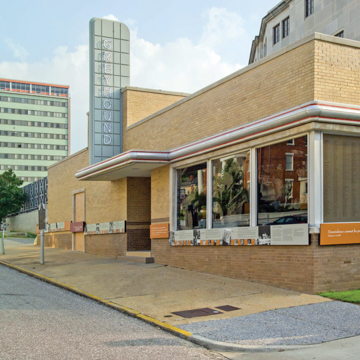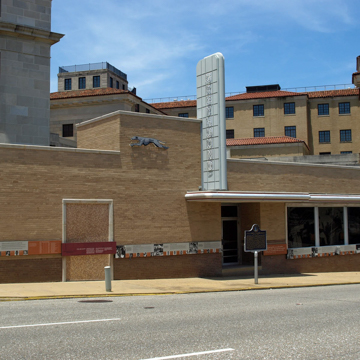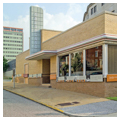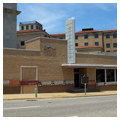You are here
Freedom Rides Museum
This 1950s Greyhound Bus Station is a middling architectural example when compared to the sleek modernistic buildings that Greyhound erected in the middle of the twentieth century in pursuit of middle-class American travelers. But this station, located in the shadow of the Frank M. Johnson Jr. Federal Courthouse, is of transcendent importance in the struggle for racial justice and serves as a reminder of the period of racial segregation.
Montgomery’s bus station was one of 65 or so that William Strudwick Arrasmith (based in Louisville, Kentucky) designed for Greyhound over three decades. His first Greyhound design was a sensational 1937 station in Louisville that incorporated blue, porcelain-enameled steel panels into a Streamline Moderne design. In contrast, the 1951 Montgomery station, as well as the Birmingham terminal built the same year, reflect a post-World War II evolution in Arrasmith’s work, a shift that began with his 1949 Greyhound station in Akron, Ohio. In the two Alabama buildings, as in Akron, Arrasmith used beige brick walls in place of enameled panels or smooth limestone surfaces. Crisply squared-off corners replace the Streamlined curves—creating sturdy, blocky buildings rooted firmly to the ground.
The architect retained a few earlier features, such as the horizontal glass windows, an iconic pylon with the Greyhound name, the “running dog” logo, a darker-colored band at sidewalk level, and a shallow asymmetrical metal canopy. Taken together, these tie the later buildings to Greyhound’s brand while presenting a more modernist, if less streamlined look.
The layout of the Montgomery Greyhound Station with segregated waiting areas was similar to structures throughout the South, where state and local laws, as well as local custom, mandated separation of the races in public places. White passengers entered through the main entrance into a spacious waiting room with a ticket window, lunch counter, and restrooms. African American passengers entered through an open portal a few feet to the left, just under large, red, wooden letters spelling out “Colored Entrance.” Covered bus bays led to a smaller waiting room behind the main (“white”) waiting room, with its own ticket window, lunch counter, and restrooms. A central ticket office serviced both waiting areas and a single kitchen provided meals for both lunch counters.
Although U.S. Supreme Court decisions in 1946 and 1960 officially prohibited racial discrimination on buses and in terminals used by interstate travelers, these rulings were not enforced in most southern states. State laws requiring segregation on in-state routes were, however, strictly enforced. The result was architectural arrangements and signage in both bus and trains stations that reinforced state and local Jim Crow laws. On May 20, 1961, Montgomery’s Greyhound station gained international attention when a group of young travelers calling themselves the Freedom Riders arrived in the city. The Freedom Riders left Washington, D.C. on May 4, and headed through the Southeast to New Orleans to test the Supreme Court decisions outlawing segregation for interstate travelers on buses and in bus stations. When they reached Alabama, violence in Anniston and Birmingham led most of the original thirteen riders to complete the trip from Birmingham to New Orleans by airplane. But at that point, college students from Nashville, who had used nonviolent protests to desegregate that city’s department stores and lunch counters, took up the Freedom Ride cause. Arriving by bus at the Montgomery Greyhound station, the group was met by a violent, police-sanctioned mob determined to preserve racial segregation. The ensuing violence horrified the nation and for the first time, the Kennedy Administration sided with civil rights protestors, sending federal marshals to Montgomery and pushing the Interstate Commerce Commission to issue regulations ending racially segregated transportation, which went into effect less than six months later, on November 1, 1961.
Following the demise of legal racial segregation, Greyhound decided to enlarge the Montgomery station. In 1968, Arrasmith’s successor firm, Arrasmith, Judd, Rapp and Associates, prepared plans for a single large waiting room, one restaurant, and one set of restrooms. The former “colored” waiting room was incorporated into a large baggage handling area. The construction drawings also called for obliterating all exterior evidence of the “colored” entrance with solid brick. The limestone architectural surround of the doorway was left visible on the exterior, but walled over inside. The door opening itself was filled in with beige and brown bathroom tile. Still to be seen above the sealed opening are the tiny holes supporting the red letters once identifying the segregated entrance.
In the 1990s, the U.S. General Services Administration (GSA) acquired the Greyhound station and other surrounding properties as part of a project to expand the adjacent federal courthouse. Initial plans called for the station’s demolition but the Alabama Historical Commission, working with a coalition of concerned local citizens as well as Federal Judge Myron Thompson, reached a compromise preservation solution. The main terminal became home to the Freedom Rides Museum, run by the Alabama Historical Commission, but the original bus bays as well as the 1968 front and rear additions to the building were demolished. At 10:23 AM on May 20, 2011—fifty years to the minute after the arrival of the Freedom Riders at the station—the Freedom Rides Museum opened its doors. Across the front of the building, Ralph Appelbaum and Associates designed a series of award-winning interpretive panels that tells the story of this milestone struggle for equality.
References
Arsenault, Raymond. Freedom Riders: 1961 and the Struggle for Racial Justice 2006. Oxford University Press, USA.
Thornton, J. Mills. Dividing Lines: Municipal Politics and the Struggle for Civil Rights in Montgomery, Birmingham and Selma. Tuscaloosa: University of Alabama Press, 2002.
Wrenick, Frank E. The Streamline Era Greyhound Bus Terminals: The Architecture of W.S. Arrasmith. Jefferson, NC: McFarland and Company, 2007.
Writing Credits
If SAH Archipedia has been useful to you, please consider supporting it.
SAH Archipedia tells the story of the United States through its buildings, landscapes, and cities. This freely available resource empowers the public with authoritative knowledge that deepens their understanding and appreciation of the built environment. But the Society of Architectural Historians, which created SAH Archipedia with University of Virginia Press, needs your support to maintain the high-caliber research, writing, photography, cartography, editing, design, and programming that make SAH Archipedia a trusted online resource available to all who value the history of place, heritage tourism, and learning.




